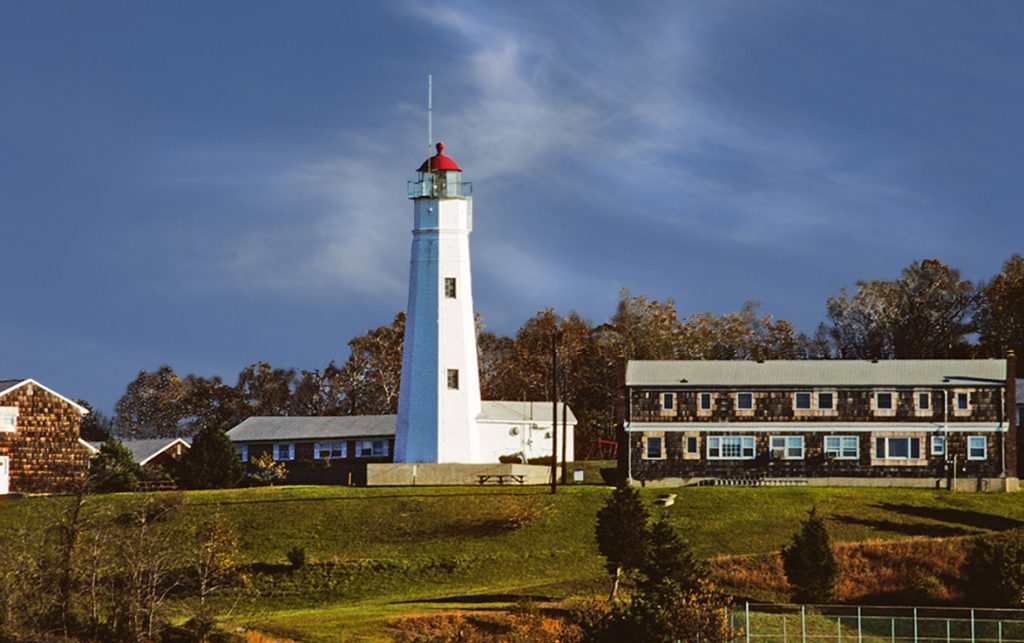
When sailing western Long Island Sound at night, a reassuring steady beacon of white light can often be spotted 17 miles out from its source. Shown from the 73-feet fieldstone tower that stands on a bluff, the lighthouse at Eatons Neck has served mariners for over two centuries.
In 1795, Joshua Perry, a Huntington, New York Presbyterian minister and part-time surveyor expressed his concern regarding the “great reefs of rock” extending three-quarters of a mile out from the point at Eatons Neck. The local sailors indicated that it was the site of many shipwrecks. New York State and the Federal Government responded quickly. The funds were appropriated and a lighthouse was built in 1798. It became operational during the following year. But despite its warning light, historian Mary Voyse recounted that during the intense winter storm of December 21, 1811, “60 ships and their crews were lost. So severe was the weather that sheep died and chickens were frozen to death.”

Though Long Island Sound became a convenient waterway for vessels traveling from the Port of New York to harbors along the waterway and farther north, other navigational hazards continued to endanger ships. The 1822 edition of American Coast Pilot warned of Stratford Shoal, a site where there was “but two feet of water, at low water.” However, it also indicated that “a deep bay, called Huntington’s Bay, could accommodate a ship of any size, where it could anchor with safety.” In 1837, a lightship was posted at Stratford Shoal (Middle Ground), where one remained on station until construction of a lighthouse some 40 years later.
When Eatons Neck Light came into operation, an estimated 200 wooden-step, spiral staircase led to the lantern room. In 1868, they were replaced with metal grating steps, painted black. At first, the beacon projected its light using oil lamps whose fuel may have been lard oil, as was the case at many other lighthouses of that time. One can only imagine the odor of burning lard! At some point, the lamps’ fuel was changed to sperm oil, widely known as spermaceti. It was, however, very expensive, the equivalent of $200 per gallon in today’s values.
In 1837, there were numerous complaints voiced about the Eatons Neck; its beacon was not visible beyond 7 to 8 miles. Inspection of the lantern found that all of the lamps were defective. “The keeper admitted that the lights were bad.” Keeper John Gardiner had reported the matter to the then head of the Lighthouse Establishment Stephen Pleasonton, but he did nothing. Finally, during the following year, the tower was refitted with 12 lamps and reflectors arranged around two circular tables. The light was then visible at a maximum of seventeen and a half miles. In 1858, the lantern was refitted with a third-order Fresnel lens, powered by four whale oil lamps. The lens was electrified in 1821 and over a century and a half later, it remains in service at the lighthouse. The light was automated in 1961.
Throughout its history, Eatons Neck was witness to many shipwrecks, but by far the worst maritime disaster for the entire Sound was the loss of SS Lexington. During the winter storm of January 13, 1840, the 207-foot paddlewheel steamer was en route from New York City to Stonington, Connecticut. It was loaded with passengers and 150 bales of cotton. As the vessel was traveling just north-east of Eatons Neck, an engine’s smokestack overheated causing a nearby bale to catch fire. Heavy winds then spread the flames and soon the entire vessel was ablaze. Attempting to escape the inferno, passengers jumped into the water only to die of exposure. Some lifeboats were launched, but they were immediately swamped. Of the estimated 150 or more passengers and crew, only four survived by climbing up on floating bales of cotton. A sloop soon aided in the rescue of three survivors. However, David Crowley, the second mate, drifted some 25 miles on his bale of cotton, before reaching a beach near Baiting Hook, Long Island. On the following morning, vessels searching for survivors found pieces of the Lexington scattered in the waters from Eatons Neck to about 15 miles east of the lighthouse. Parts of the wreck now lie in 140 feet of water, a short distance from the Middle Ground Lighthouse, “near the path of the Bridgeport – Port Jefferson Ferry.”
On December 30, 1960, another marine tragedy occurred at the doorstep of Eatons Bay. The 96-foot tug Gwendolyn Steers was heading for Huntington Bay in a raging storm, with sustained 60 mph winds and gusts of up to a reported 90 mph. At 4:30 pm, the tug’s captain radioed Eatons Neck, stating that the tug was taking on water, but the vessel was in no immediate danger. Her “pumps and engines were working properly.” The Coast Guard radioman assured the captain that they would stand by “on the distress frequency in case they needed assistance.” About 10 minutes later, the station’s commander called the tug, but her captain continued to maintain that they were in no immediate danger. A short time later, when the station’s commander attempted to contact the tug, there was no answer. The station’s 36-foot rescue whaleboat was launched but the tug was nowhere to be found. She had sunk taking the lives of her nine crewmen. The tug which now sits upright in 38 feet of water with only 20 feet over her pilothouse, is now a favorite dive and fishing spot at the mouth of Huntington Bay (40 57.282’N/73 25.758’ W).
Over its 122 years of service, the keepers and U. S. Coast Guard personnel of Eatons Neck have gone to the aid of disabled vessels and saved countless lives. In 1850, Keeper Benjamin Downing and his 16-year-old son headed out in heavy seas for a capsized schooner near the entrance of Huntington Bay. They were able to save the life of one crewman, but the other crewman, who had attempted to swim to shore, was met with “a watery grave.” Over the years, there were many other examples of selfless service by those manning the outpost. During World War ll, 150 Coast Guardsmen were stationed at the site, as part of the war effort. Today, the men and women of Eatons Neck continue to serve in “marine safety, aids to navigation, ice operations, coastal security, drug interdiction, defense readiness, marine environmental protection and various other types of law enforcement.”
In 1972, the New York State Board of Historic Preservation nominated Eatons Neck Lighthouse to be placed on the National Register of Historic Places. It was added to the register during the following year. Access to the lighthouse property is limited to official business only. It is, however, a beautiful sight from the water, a safe distance from the bluff on which it stands.
